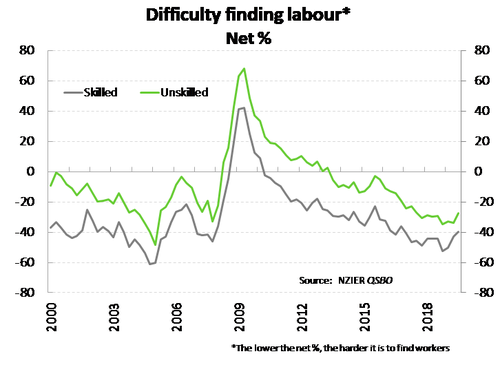
Key Points
- Business Confidence deteriorates along with profitability. Poor pricing intentions has cut inflation expectations. Businesses are worried.
- RBNZ action has failed to spark the fire needed under business intentions. More work is required.
- The protracted, and worsening, malaise amongst business, is likely to induce another RBNZ response. We now expect another 50bps cut(s) to just 0.5%. And we wouldn’t rule out a 50bp in November. But it is the Government that must step up.
Summary
The focus this week is all business, and confidence is crumbling. Businesses have highlighted weak demand, capacity constraints, (Govt) policy uncertainty, and poor pricing power as reasons to worry about profitability, reduce investment intentions, and lower inflation expectations. All of the above point to growth running at or around 1%, half the current run rate, and a third of what we need. The deterioration in business intentions demands a policy response. We will get a monetary policy response, but what we really need is a fiscal policy response. The Government continues to lie in wait through fear of breaking fiscal responsibility rules, that have proven irresponsible. So, we must expect the RBNZ to do more, with diminishing returns.
We now expect the RBNZ to cut to just 0.5%, and we see a good chance the bank delivers in just one move in November. The risk of another move, as bank capital requirements bite, to 0.25% is uncomfortably high, and will hurt savers.
The release of both the ANZ Business Outlook survey for September and NZIER’s QSBO for Q3, have disappointed. Both surveys were weak, and worsening. The surveys differ in their respective respondent groups, but unsurprisingly they are telling us the same thing. Firms are in a dispirited mood. Headline business confidence continues to linger around lows last seen during the GFC. But more concerning has been Firms’ outlook for their own activity, a leading indicator of GDP growth. The outlook for activity has continued to deteriorate. Both surveys show more firms than not anticipate falling activity into 2020. For the RBNZ, the forecast pickup in growth over the second half of 2019 may not materialise. Also, firms’ pricing intentions and inflation expectations are falling. A further policy response is likely to be needed to ensure inflation is on track to return to the RBNZ’s 2% target mid-point. We expect the RBNZ to cut the OCR by a 25bps to 0.75% in November. There is now a risk, of course, that the RBNZ delivers a 50bp move to 0.5% in November.
NZ business have gone from worrying about policy uncertainty following the last general election, to worrying about weakness in general conditions. Firms are now slowly losing the enthusiasm to hire and invest. Moreover, there is an inability among firms to pass on rising costs to their customers, and this has hammered profitability. Cost increases have come from policy change, such as the large hikes to the minimum wage, but also from capacity constraints and difficulty finding suitable staff – especially in the building industry.
A lack of demand is evident
The survey was a story of falling demand both from our trading partners, but also at home. A net 11% of firms experienced a fall in trading activity over the third quarter – the lowest level in nine years. NZIER pointed out that at face value this reading points to third quarter annual growth of only 1%! That’s well below the 2.1%yoy recorded in Q2, which was already well below trend of ~2.75% for NZ. Weakness in demand was evident across industries and regions.
There were a few glimmers of hope in the survey – but only glimmers. The outlook for domestic trading activity did improved from -4 to 0, and a net 11 % of firms are looking to expand headcount next quarter. However, we have been here before. A more optimistic outlook gets snuffed out by reality.
Capacity less of a constraint
Today’s QSBO contained several pieces of evidence to suggest that there is more spare capacity out in the economy than previously thought – meaning more policy stimulus is needed to get inflation back on target. Capacity utilisation pulled back a touch in the quarter, cost pressures eased, and firms found it slightly less difficult to find staff – particularly unskilled staff.
All this indicates less inflation pressure, not what the RBNZ would want to see. A net 1% of firms actually cut prices in Q3, down from a net 12% increasing in June, and this is well below the survey average of 25% hiking. Only a net 7% are looking to increase prices. This is consistent with a fall in inflation expectations seen in Yesterday’s ANZ survey and poses a downside risk to future inflation.
Market Reaction
We had assigned an uncomfortably high 40% probability of a move to just 0.5%. The confidence surveys have tipped us over the line. There’s now a 60-70% chance of a cut to 0.5%, in our opinion. And we therefore assign another uncomfortably high 40% probability of a (banking capital requirement) cut to just 0.25% in early 2020.
We must not rule out another 50bps cut in November. The RBNZ have shown us that if they think it necessary, as we do, then they’ll deliver it up front. Both the RBNZ and RBA could be at 0.5% before Christmas.
The reaction in financial markets was surprisingly muted. But, to be fair, there’s a lot of bad news priced in already. The wholesale interest rate market has remained well bid, with rates hovering around record lows. An RBNZ move to 50bps would see rates a little lower, as most of that move is priced in, but for that much longer. The OIS strip has a terminal of 0.58% priced. An RBNZ rate cut to 0.5% would see it move to ~0.4%, as the risk of more is always priced. The 2-year swap rate, used by banks to hedge 2-year fixed rate mortgage flow, is currently ~93bps. An RBNZ move to 50bps, should see the 2-year swap rate trade towards 75bps. The 2-year Government bond rate will likely trade from ~80bps today, to ~50bps. That means the 10-year Government bond rate will go sub-1%, from ~1.10% today, to around 90bps.
The Kiwi currency has remained under downward pressure at 0.6262. Short-term, it can go anywhere, on good or bad news. But over the next 3-to-6 months we continue to forecast a volatile descent in the bird to 58c. Not far now.

